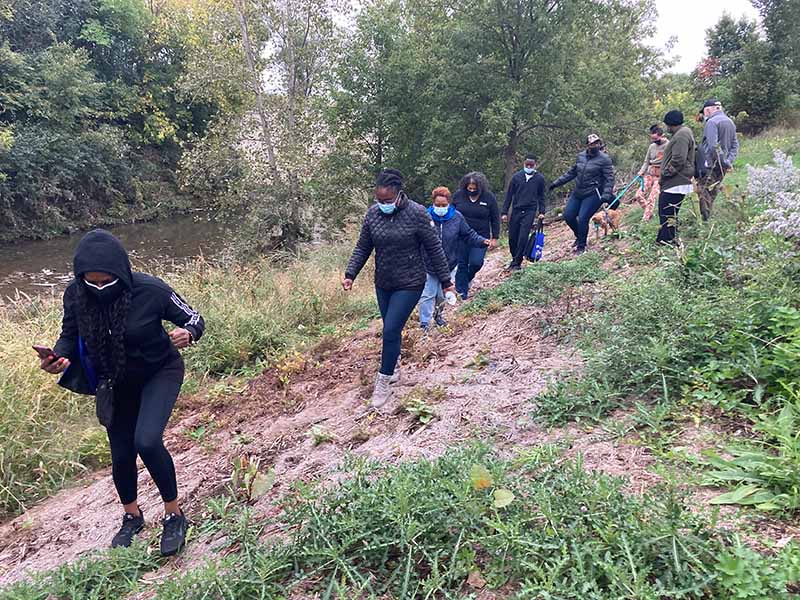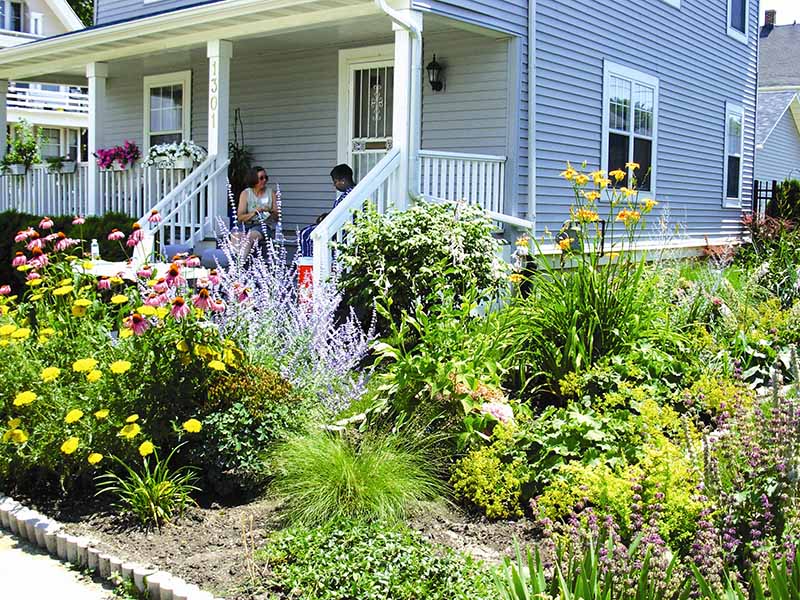Nadia Vogt is a senior projects manager and Kate Morgan is a senior public engagement specialist for the Milwaukee Metropolitan Sewerage District.
Who are you/what is your role?
Nadia: I am a senior project manager who helped write the Milwaukee Metropolitan Sewerage District (MMSD) resilience plan and oversee its implementation.
Kate: I am a public engagement specialist who coordinates engagement and outreach for Milwaukee Metropolitan Sewerage District’s projects.
What led you to look at green infrastructure?
Nadia: MMSD is a wastewater reclamation facility serving 28 municipalities in southeastern Wisconsin. As part of our mission, we also address flood-risk in Milwaukee County on the urban rivers. As part of the critical infrastructure for the county, we must figure out how to function in a changing climate.
Equity is a lens that we are now integrating to our work. We are asking, “How do you leave these communities better, with more resources or other things that they need?”
We developed a resilience plan using a holistic management planning approach to identify the risks and opportunities to reduce those risks. Our regional resilience plan looks at environmental risks, economic risks, and community risks. The plan was developed with developers, agencies, and many stakeholders from the Milwaukee region.

Is it unusual for a utility to be involved in community development projects?
Nadia: Yes, but more utilities are headed in this direction. As a government agency, we must stay within our mission to manage water and protect public health. We use community partnerships to try to meet the rest of the community’s needs. For example, the district is in the design phase of a major flood management project in the 30th Street Corridor that is sited along one of the most dangerous streets in the city. The residents have long advocated for this critical issue be addressed.
As an agency, we can respond to this issue by identifying opportunities for the community to advocate for their needs in conjunction with the project design process. While we cannot address the need ourselves within the framework of the flood management project, we can help them identify a pathway forward to address this issue.
We always ask ourselves, “What do our investments today mean for the community in 10 years?” When we come into a community/neighborhood, just like in an ecosystem, we know that any work we do will have far-reaching ripple effects. We try to be extremely intentional about making those ripples positive.
How do you support green infrastructure investments?
Nadia: We support green infrastructure in the region in multiple ways. Financially, we support municipalities through green project management or funding. We also provide matched funding support and provide rain barrels and rain gardens for community members. We look at ways to make the grey infrastructure function better by adding green infrastructure strategically. This past decade was the wettest decade on record and that has accelerated our commitment.

How are you serving at-risk communities in Milwaukee?
Nadia: We know that climate change is happening, but in many of the communities we serve, there are many more pressing needs, like getting food on the table. In our projects, we create a communications approach based on working with and listening to people. We take the needs of the community into consideration when we plan the project. Amenities like parks and trees are considered.
We know there are disproportionate impacts in our more vulnerable communities, so community decision making is extremely critical. Everything needs to be bilingual in both written form and in verbal form via translation services for public meetings. We must be conscious of language preferences of individuals living or working in our project areas and use accessible language that resonates with people.
When considering green infrastructure, we are changing their neighborhood, so we ask: “What do you want it to look like? How do you want it to function? What are your questions? How will you create stewardship over these spaces so that they are maintained?” We are not saving the world, but we’re doing our part by making conscious project development decisions. It’s our job to listen.
Kate: The most important thing we do is to help strengthen communities through our public engagement for projects. We create a framework within which people’s voices are both heard and valued. We seek to establish trust, which is the basis for authentic communication.
While the impacts of future climate change on the lives of our communities is uncertain at this time, if there are established relationships founded on respect and trust, we can come together as strong communities with a rich diversity of skills, perspectives, and resources to meet those challenges whatever they may be.
What advice would you give to other municipalities?
Kate: It is important to recognize community members as your central partner for projects. We have moved away from a transactional, check-the-box approach for project outreach to a relationship-based approach. We are partners in our community with our communities. And that relationship extends beyond the project. For one project, we started outreach two years in advance of the design phase of the project. We invested in relationship building and establishing trust.
In some cases, residents may not be aware of options or have experiences to help inform their thinking prior to attending a public meeting where they will be asked to make choices. We want to prepare residents for participation in the design phase of a project; to be able to come to the public meeting with a better understanding of options and possibility to better inform their input.
For example, before the pandemic, we organized a tour for residents to visit neighborhood parks in other parts of the city. This experience got them excited about options they had not imagined and opened their thinking to new ideas of what might be possible in their own neighborhoods. In this way, we provide residents with experiences and resources to prepare them for the design process, valuing them as experts on the places where they live and on the needs of their communities.
Do you have hope for the future?
Kate: We are going to have incredible challenges facing us; it is difficult to even imagine what those might be. And yet, I have hope. I understand hope as a verb; and I see hope being created in many places and in many ways. My hope is based on all these nodes of committed, collaborative action that are creating change throughout the City of Milwaukee. Yes, I do have hope.
The views and opinions expressed in this interview are those of the authors and do not represent official policy or position of the University of Wisconsin-Madison or the Wisconsin Initiative on Climate Change Impacts.
For More Information
Nadia Vogt
Senior Projects Manager
Milwaukee Metropolitan Sewerage District
NVogt@mmsd.com
Kate Morgan
Senior Public Engagement Specialist
Milwaukee Metropolitan Sewerage District
KMorgan@mmsd.com